I have blogged about my second shot attempts (here and here) during the Chinese New Year Open House. I have also blogged about my failure to find the original nutmeg trees on the Istana grounds. This time round, I will blog about my search for royalty in the Istana. Will I succeed?
It is good to read up on the Istana before your visit. After all, you only get a few shots at it every year. Sure, you can ogle at the swans or the fountain, though I think there are much better ones around elsewhere. I found an enticing target from my research. She would be my prized catch in the Istana.
I call her The Queen, a statue of Queen Victoria on the Istana grounds. At 120 years old, she has seen her fair share of adventure and hardship. She used to stand comfortably in the alcove of the State Room (then called Victoria Room) until the 1960s when she was moved to the Victoria Memorial Hall and subsequently to the National Museum store. The various shifts over the years caused her great distress. When she resurfaced in 1994, she was found to have sustained injuries on her body, including her nose.
1953 archive photo of the Queen in the alcove of the State Room. I think it was Open House, that explains the kids.
Open House map of the Istana. I finally found The Queen at the pond on top at one o' clock position.
As you can see from the map, The Queen is found not far from the Istana building. She is at the edge of the area accessible to the public. You can see a lot of 'no entry beyond this point' sign in the Istana.
As I treaded my way to The Queen, a sight of what is to come greeted me - three
Left: The three queens posing with style. The rubenesque woman on the right reminds me of Queen Victoria.
Right: A portrait of Queen Victoria.
Left: The pond marked on the Istana Open House map.
Right: Queen Victoria is just behind the pond.
When you reach the end of the pond, Her Majesty awaits you. As you stand in awe, do not forget to pay your compliments.
Left: A visitor standing in awe of Her Majesty.
Right: The photographer paying homage to Her Majesty. Long live the Queen!
So here is Queen Victoria who used to stand comfortably in the alcove of the State Room. Today with the pavilion roof over her, she is still subjected to the wind element. The roof isn't going to help against our torrential rainstorm either.
The Queen taken from a similar angle as the 1953 archive photo earlier in the blog.
Earlier I described The Queen as 120 years old. If Queen Victoria is still alive today, she would be a whopping 190 years old. Coincidentally this year is the 190th anniversary of British founding of Singapore, so Queen Victoria was born in the year Singapore was founded.
At the base of the statue, we have a clue to the age of The Queen.
Gist: The Queen was presented by the Chinese community of Singapore to be placed in the Government House.
Surprisingly the statue was not a memorial by Her Majesty's 'ang moh' subjects but the Chinese community of Singapore. Did the Chinese community love Queen Victoria last time, considering it was a largely immigrant society from China and the reign of Her Majesty saw the lowest point of Anglo-Chinese relationship. Think the two Opium Wars and the plundering of Chinese imperial treasures by the English. I suspect the Chinese community refers to English-speaking Straits Chinese in the government service. The average coolie on the street probably did not know of the statue's existence.
The base inscription tells us the statue was presented in the year of Her Majesty's Jubilee. This was the Golden Jubilee of 1887, though the inscription was marked in the year 1888 and the Istana website refers to the Jubilee Year as 1889. I'm confused frankly, but the discrepancy does not change the fact The Queen is a Supercentenarian.
I also found two portraits at the base of the statue.
Are the portraits Queen Victoria and her husband Prince Albert?
I'm guessing they must be people dear to Queen Victoria. One possibility could be Victoria and her husband Albert but when you consider both were born in the same year (1819) and the portrait shows an old bearded man with a young attractive lady, the hypothesis weakens. Another possibility could be a son and daughter of the couple. Unfortunately I have no way to verify either hypothesis.
Finally, here is a close-up of The Queen. There is something incongruous about her face ....
Did The Queen knock her nose? Sign of her injury can still be seen.
Earlier I mentioned The Queen sustained injuries over the years. One particular spot was her nose. So here we have a statue of Her Britannic Majesty, ruler of an Empire on which the sun never sets, with her injured nose not properly restored.






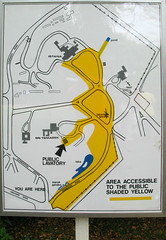
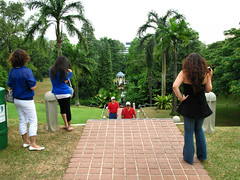

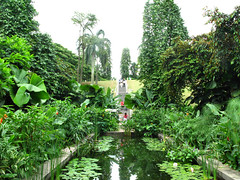
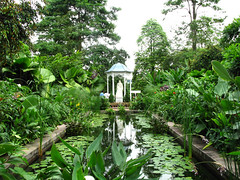

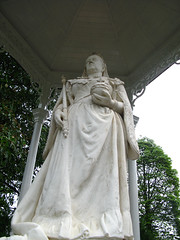
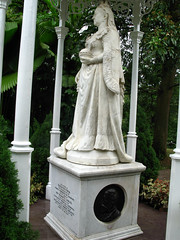
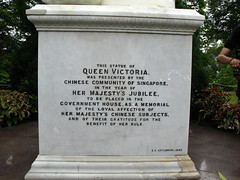
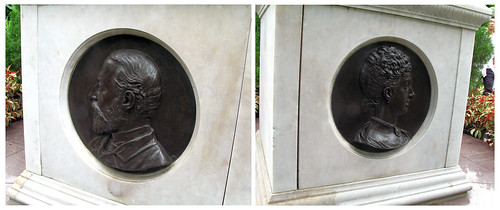
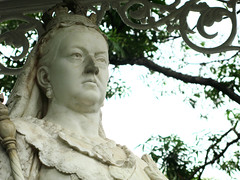










7 comments:
Ahh... we have already paid compliments to the Queen here and here.
Seriously, I think the statue is not that very important. If it is, she wouldn't be standing out here welcoming visitors to pay tribute.
Poor Queen.
Thanks for teaching me the meaning of the word "rubenesque". According to one definition, the word means "Big Beautiful Woman" (commonly abbreviated as BBW) and is a neologism most frequently used in the context of affirmation of or sexual attraction to women who are overweight or obese.
Hmm... I didn't know you have a weakness for rubenesque women, Icemoon. :p
victor, seems to be this young man has a liking for all things old - old buildings, old cars, old trains, old women....old word, which i cannot find in my dictionary.
YG, use on-line one lah. Why use traditional old dictionary?
Hi, the two bas-relief on the pediment are portraits of Queen Victoria's eldest son and his wife, King Edward VII and Queen Alexandra. They would have been Prince and Princess of Wales at the time of the presentation of this statue.
Job Ang, thanks for checking the blog and your very interesting piece of information! Will update the blog to include that.
Post a Comment